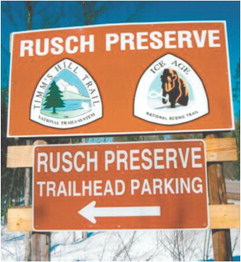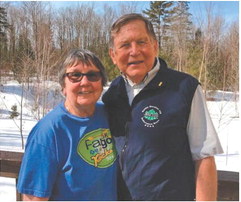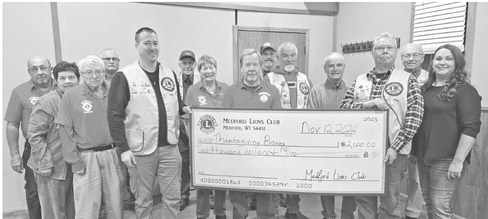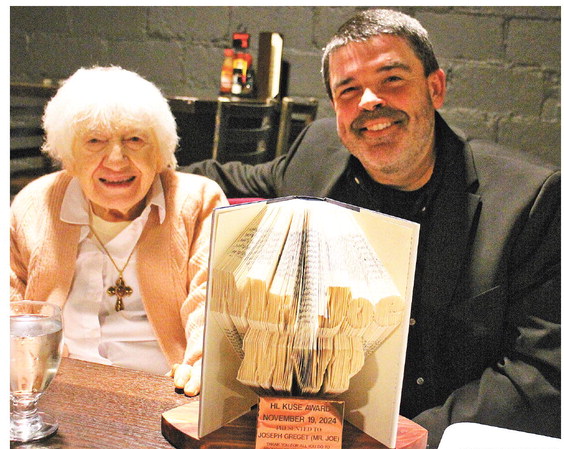Rusch Preserve —Where five trails meet


For those looking to get out of the house while continuing to social distance, it doesn’t get much more secluded than Wisconsin’s vast forests, and the Ice Age National Scenic Trail provides a great break from life while presenting spectacular scenery.
Since 1983, Bob Rusch, environmentalist and retired Taylor County district attorney, has had a hand in the building of the Ice Age Trail, including selling (on the low) and donating plots of land through which the trail runs to the Ice Age Trail Alliance. Starting off as a 25 acre plot on Hwy C, the land was named the Rusch Preserve in honor of Bob’s parents, Herman and Martha Rusch.
Over the years, Bob and his wife Ann added more land to the preserve to grow it as much as they could, including two sections that allowed the Ice Age Trail to cross between Hwy C and Rustic Road No. 1. This section of trail makes up the southern most part of the Timm’s Hill Trail as well, with the 10 mile path ending at its namesake hill; Timm’s Hill itself is a moraine created during the last Ice Age. In addition to selling and donating land, the Rusches helped the Alliance obtain easements on other portions of land, further expanding the preserve.
Recently, in 2019, they made their most expansive addition yet, gifting three separate 40-acre plots of land to the Alliance, which added 120 acres and brought the Rusch Preserve to a total of 170 acres. Signs dot the trails explaining the history of different areas to passersby.
The first plot of land is referred to as Filas Farm, named after a Polish man who, with his family, cleared the land of trees and brush and operated the area as a diary for many decades. Around 1960 the family abandoned the land, which was later acquired by Ann, who together with Bob planted a vast array of pine trees in the old farm field, sprucing up the scenery significantly.
West of Filas Farm is the Tote Road, an area purchased by Rib Lake founder J.J. Kennedy in 1881. According to Bob, who is also founder and manager of the Rib Lake Historical Society, it was Kennedy’s first purchase in the area as he sought to harvest pine trees. Kennedy set up lumber camps in the forest, and built up the rudimentary tote road stretching over hills and meandering swamps so that supplies could be brought to his laborers. The tote road can still be seen to this day, intersecting the Ice Age Trail at Tote Road Hill. In an article Bob wrote for the Ice Age Trail Alliance, he described the difficulty workers had navigating the rudimentary 19th century road: “The tote wagons were heavily loaded with supplies, pulled by two horses, and had one crude hand brake. The teamster would stop his wagon at the top of Tote Road Hill, get off the wagon, and chain its rear wheels to keep them from turning. Then he would climb back on his seat and urge his team to go down the hill. The rear wheels of the wagon would skid all the way down. Once safely at the bottom of the hill, the teamster would remove the wheel chains and resume his journey.”
Two acres of hemlock trees is located in the Tote Road 40, with a ski trail going through the lot currently, and there are plans for the Ice Age Trail to follow beside the hemlock stand in the near future.
The third and final plot of land is the Terminal Moraine. The landscape here is accented by a steep 25 foot incline in the land which, according to Bob and confi rmed by glacial geologist Dr. David Mickelson, was created when glacier movement halted there 12,000 to 18,000 years ago. The ice prevented organic material from being deposited on the land on which it sat, further building up the outside embankment while leaving the covered area a low wetland once the glacier finished melting. The Ice Age Trail will eventually run along this moraine, splitting in two separate paths so people can choose to either hike at the bottom of the ridge, or along the top.
The remains of Rib Lake Lumber Company’s Camp 6, in operation from 1911-1914, can be seen at the center of Rusch Preserve, with signs posted that explain its history. Building foundations and an old root cellar can still be viewed after over 100 years of the site’s abandonment.
Rusch Preserve hosts three hiking trails: Camp 6, Ice Age, and Timm’s Hill. There are two snowshoe and ski trails as well: the Beginner Ski Loop, and the 20 mile Nordic trail. The Nordic trail makes for particularly exquisite hike For an entire weekend of adventure while simultaneously avoiding packed crowds, the preserve has four primitive campsites, a well of potable water, and picnic tables. Kiosks with maps, photos, brochures, and other information are available for hikers; Rib Lake Historical Society has over 10,000 antiquarian documents preserved online that share the history of Rib Lake and the surrounding area, and a historical marker based on the documents is being planned for Tote Road Hill.
The stories behind the logging camp, abandoned farmland, antiquated roads, and geological glacial impact makes the Rusch Preserve of particular interest for those keen on local history, and when coupled with the tranquil forest scenery makes for both a relaxed hike, or a weekend get-away.
Bob and Ann Rusch



